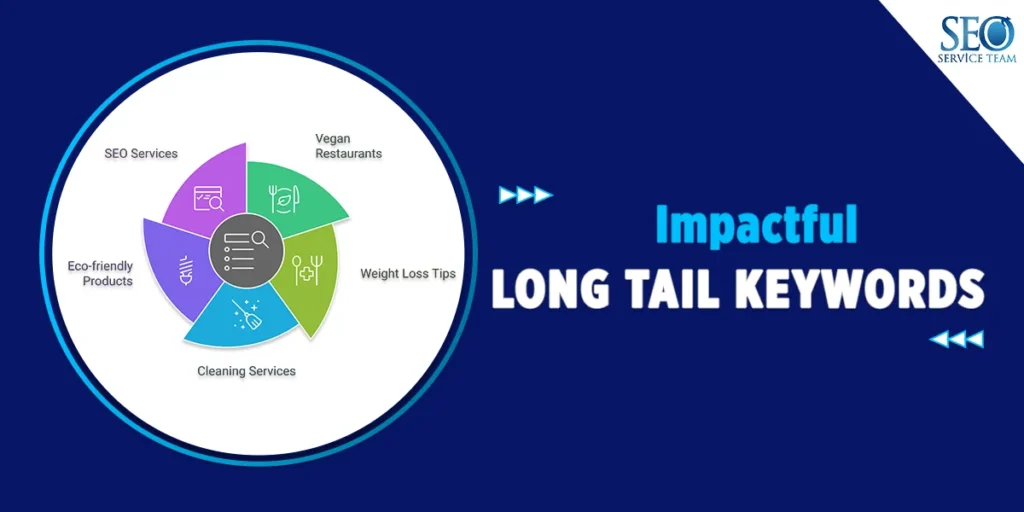
Getting your website noticed in an SEO-competitive world is not easy at all. While many websites focus on common search terms, it is crucial for SEO professionals to understand that targeting specific keywords can lead to significant improvements.
Long tail keywords are longer, more specific phrases compared to generic terms and usually consist of three to five words. Targeting these keywords can significantly enhance your website’s reach, allow you to connect with specific audiences, and increase your conversion rates.
In this article, you will learn about long-tail keywords, their benefits, SEO strategies, and their overall importance.

What Are Long Tail Keywords?
Long tailed keywords are specific keywords with longer phrases that people use when searching for particular information. Unlike short keywords like “shoes,” which have millions of results, long tail search keywords like “best running shoes for flat feet” focus on specific information and are less competitive.
When users search their query on SERPs, these keywords help you reach your target audience. In the same way, informative keywords can help capture audiences seeking in-depth information.
Long tail searches often have lower search volumes but can result in higher conversion rates. Including them in your content helps attract search audiences with specific intent. These keywords are important for building an effective SEO strategy that enhances online visibility.
Benefits of Using Long-Tail Keywords:
Long tailed keywords provide you several advantages that impact your overall SEO strategy. Here are some benefits of long tail search keywords:
- It has low competition that make it easier to rank.
- It helps you to achieve higher conversion rates from targeted search results.
- Long tail searches help you to improve relevant keywords to get more leads.
- When you optimize your content for specific search queries, these keywords improve the user experience.
- Long tail keywords help you to optimize content for local SEO to capture local traffic.
- Long-tail keywords match search intent, making your content more valuable to your target audience.
Long Tail Keywords Examples That Deliver Results:
Long tailed keywords help illustrate user search behaviour, revealing that users often know exactly what they need. For example, a bakery could attract local customers with specific long-tail searches such as ‘gluten-free birthday cake in Chicago,’ which can effectively increase local traffic. Below are additional examples for your review.

1: Best vegan restaurants in New York City
2: How to lose weight without dieting for women
3: Affordable home cleaning services in Los Angeles
4: Buy eco-friendly yoga mats online
5: Best SEO Services in Pakistan
Why Long Tail Search Keywords Are Important for SEO?
Long tail searches are crucial for reaching targeted audiences, allowing users to find your website more easily. These keywords reflect the search intent of users, making your content more relevant to specific groups.
People often use long-tail searches when they’re looking for very specific information. By integrating these keywords into your content, search engines can better index your site. Additionally, long tail keywords are especially beneficial for smaller websites that might struggle to compete with broad, short-tail keywords.
Using a long tail keyword research tool in your SEO plan helps uncover terms that your audience is searching for, which can improve your website’s visibility in search results.
Common Mistakes to Avoid:
Avoiding common mistakes can significantly improve your long-tail keywords strategy. These common mistakes are:
- Overusing Keywords:
Avoid using keywords excessively as it can make your content unnatural and lower its quality.
- Ignoring Search Intent:
If you don’t use long tailed keywords that align with the user’s actual search query, it can negatively impact your site’s search ranking.
- Forgetting to Track Performance:
Make sure you track how specific search terms improve your results and enhance your SEO strategy.
How to Find Long Tail Keywords:
To improve your SEO, long tail search keywords help you target the right audience. You can use tools like Google Keyword Planner, Ahrefs, and Ubersuggest to find keywords that have high search volume but low competition.
You can also use Google’s search suggestions to see terms related to your query. Another helpful method is to analyze your competitors’ top-ranking content to find useful keywords.
By using tools like SEMrush or Ahrefs, you can discover the keywords your competitors are targeting. Including these keywords in your content can help attract more visitors and improve conversions from your target audience.
Conclusion
Long tail searches are an crucial part of any SEO strategy. They allow you target the right audience and drive more relevant traffic to your website. By understanding their benefits and learning how to find the right keywords, you can improve your search rankings and attract users who are looking for exactly what you offer.
Avoiding common mistakes and using the right tools will help you make the most of long tail keywords. With the right approach, you can grow your online presence and achieve better results.

